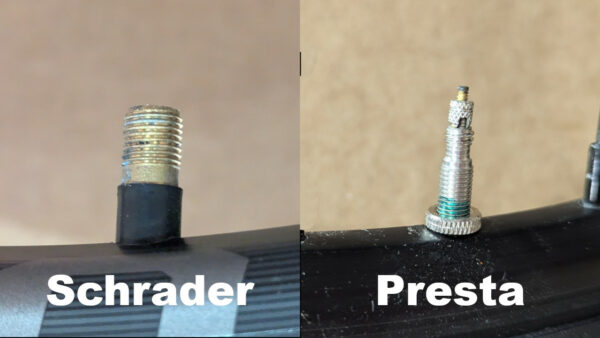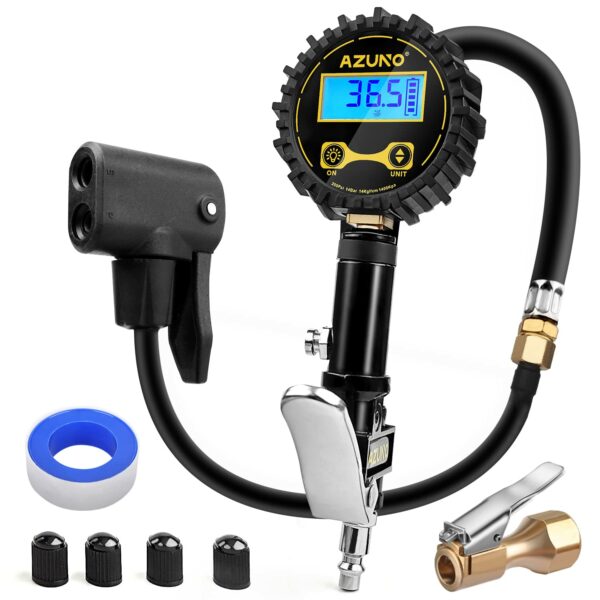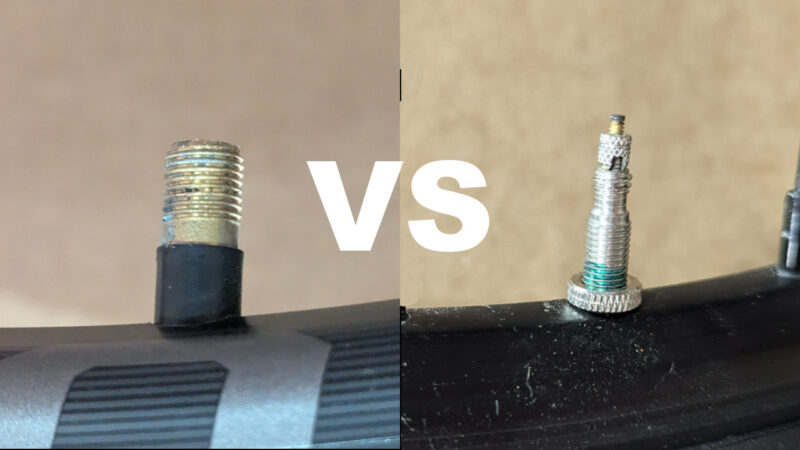If you are a redneck like me, you never knew that there were two styles of bicycle tube valve stems.
When I was growing up, there was always just one type of valve stem. Later on I learned that the ‘standard’ that you find on cars and most bicycles is called a Schrader valve, and there were also Presta valves on some bicycle tires. I of course wondered why.
Figuring that someone else might wonder why we have two types of valve stems on bikes, I did some digging and wrote this article.
Types of Bicycle Valve Stems
Just like your bike has different styles, your tires also have different ways to get pumped up. Most bike tires use one of two valve types: Presta and Schrader.
You will see Presta valves on high-performance road bikes and some mountain bikes. They are slim and can handle high air pressure, making them popular with speed lovers. Schrader valves are more common on everyday bikes. You can find them on mountain bikes, hybrids, and children’s bikes. They are wider than Presta valves and are known for their strength and compatibility with many pumps.

Overview of Presta and Schrader Valves
Let’s take a closer look at these famous valves. Presta valves are slim and have a smart air-release system. They are the sports cars of valves. To inflate a Presta valve, you need to twist off the small cap on top. Then, use your pump’s nozzle and make sure it has a tight seal for good inflation. On the other hand, Schrader valves are like trusty pickup trucks. These strong valves have a spring-loaded pin inside. When you attach a pump, the pin pushes down, making it easy to inflate.
Key Differences Between Presta and Schrader
Choosing between Presta and Schrader valves is like picking the right tool. It mainly depends on how you ride and what you need.
Let’s talk about the valve core. Presta valves have a removable valve core. This makes it easy to add sealant if you use tubeless tires. In contrast, Schrader valves usually have a fixed valve core. This can make adding sealant a little tougher.
Now, let’s look at the base. Presta valves are often narrower than Schrader valves. This means they need a smaller valve hole in the rim. This can be good for lightweight rims, but it also allows for less airflow when inflating. Finally, Presta valves often have a rubber base. This helps create a tight seal with the rim and stops air leaks.
Advantages and Disadvantages
Now that we have looked at both types of valves, let’s think about the good and bad points of each. Each valve type has its own benefits and drawbacks. These suit different types of cycling and what riders like. Knowing these differences can help you choose the right valves for your bike.
Benefits of Using Presta Valves
Presta valves are popular not just for how they look. Here are some good reasons to use Presta valves:
- Higher Pressure Capacity: They can handle more air pressure. This is great for road bikes, where keeping the tire pressure just right is important for speed and efficiency.
- Lightweight Design: Presta valves are slim. This helps reduce weight, which matters a lot to cyclists who want to lower their bike’s weight as much as possible.
- Tight Seal: They have a special threaded design and often come with a rubber base. This makes them more secure and helps prevent slow leaks.
Drawbacks of Presta Valves
While Presta valves are great for performance, they have some downsides. Here are a few to consider:
- Fragile Valve Core: The Presta valve core can be fragile. It is removable for adding sealant but may get damaged easily if not handled properly.
- Compatibility Issues: You might need adapters to use Presta valves with some air pumps. This can make inflating tires a little bit more complicated.
- Trickier Pressure Adjustment: Adjusting tire pressure precisely with a Presta valve can be harder. This is because the airflow is smaller compared to a Schrader valve.
Benefits of Using Schrader Valves
For some riding styles and preferences, Schrader valves have their own benefits. Here are the good things about them:
- Durability: Schrader valves are tough. They can handle damage and wear well, especially in tough off-road riding conditions.
- Wide Compatibility: You can use Schrader valves with many standard air pumps. This makes them easy to use every day.
- Easy Inflation: The simple spring mechanism in Schrader valves helps you inflate quickly and easily, whether you are using a hand pump or an air compressor.
Drawbacks of Schrader Valves
- Vulnerability to leaks: The push-down mechanism of Schrader valves can be prone to leaks, especially if it becomes damaged or worn.
- Bulkier: Schrader valves are generally larger and bulkier than Presta valves, which can make them less aerodynamic and more susceptible to damage in certain situations.
- Compatibility issues with some equipment: Some specialized bike equipment, such as certain wheel sets or tubeless tire systems, may only be compatible with Presta valves.
- Potential for accidental deflation: The push-down mechanism of Schrader valves can be accidentally depressed, leading to unintentional deflation of the tire.
Overall, while Schrader valves are convenient for many riders, Presta valves are often preferred by those who prioritize performance, weight, and durability.
How Do I Choose Between Presta and Schrader Valves?
When you decide between Presta and Schrader valves, think about your riding style. You should also check the tire pressure you want and if the valve works with your pump. Presta valves are great for high pressure. Schrader valves are known for good compatibility and durability.
Can I Use a Presta Valve in a Schrader Rim?
The two valve types have different diameters and mechanisms. A Presta valve is narrower and requires a special tool (a valve core remover) to inflate or deflate. A Schrader valve is wider and uses a push-down mechanism.
Trying to force a Presta valve into a Schrader rim could damage the valve, the rim, or both. It’s important to use the correct valve type for your rims to ensure proper inflation and prevent leaks.
If you have a bike with Schrader rims and want to use Presta valves, you can purchase valve adapters that allow you to use Presta valves in Schrader rims. These adapters typically fit between the valve and the rim and provide a secure connection.
Can I use the same pump for both Schrader and Presta valves?
The important question is if your pump has adapters for both Schrader and Presta valves. Most are set up only for Schrader, so if you have Presta, you will need to buy an adapter specifically for those valves or one that had dual heads, or has swappable heads. Additionally, they also make thread adapters to put on your Presta valves to accommodate Schrader fillers.

Bicycle Valve Maintenance and Care
Now that we know the players, it’s time to get the right gear for any valve issues. First, you’ll need a good pump that works with your valve type. If you use a Presta valve, make sure your pump has a Presta head. You could also buy an adapter if needed.
Next, let’s discuss sealant. If you use tubeless tires, a good sealant and a valve core remover will help seal holes and stop flats from happening. Regularly check your tire pressure with a good gauge, and make adjustments based on your weight and riding conditions.
Why Do My Bike Tires Keep Going Flat?
Essential Equipment for Valve Maintenance
Just like your bike needs a little care, your valves do too! Having a few important tools ready will help you save time and avoid stress when taking care of your valves. For tubeless setups, a valve core remover is a must-have. It makes it easy to add sealant or change a broken valve core.
When it comes to tubeless valve stems, it’s smart to keep an extra set. This is key if you often ride in tough conditions. These valve stems can be more fragile and more likely to break. Plus, no valve maintenance kit is complete without a good pressure gauge. Make sure yours is accurate and simple to read. This way, you can fill your tires to the right pressure with confidence.
Understanding Valve Compatibility
Picture this: You are excited to hit the trails, but your pump doesn’t fit your valve type. That’s frustrating, isn’t it? Before you start your next adventure, check if your valves and pump match.
Most new pumps work with both Presta and Schrader valves, but it’s smart to have an adapter ready, just in case. These small tools are cheap and can save you a lot of hassle, especially if you switch between different bikes. Remember, using the wrong valve type or a bad adapter can hurt your valves or make inflation difficult.
Step-by-Step Guide to Using Bicycle Valve Stems
Ready to fill your tires and go for a ride? Let’s simplify using bicycle valve stems in three simple steps:
Step 1: Identifying Your Valve Type
First, you need to know what you are looking at! To find out your valve type, look at the valve stem. Presta valves are thin and tall. They have a small valve cap on top. Schrader valves are wider and shorter. They have a cap that looks like the one on car tires. Once you know your valve type, you can go to the next step: inflation.
Step 2: Inflating Your Tires Correctly
Now let’s get those tires filled up! If you have Presta valves, first unscrew the valve cap. Press the valve gently to clear out any dirt. Next, attach your pump firmly, making sure it is connected well to the valve.
If you have Schrader valves, just take off the valve cap. Then, put your pump head on and press down hard until you hear a nice sound of air going into the tire. Watch the pressure gauge carefully as you inflate. Aim for the PSI range shown on the side of your tire.
Step 3: Maintaining and Replacing Valves
Like any hardworking component, your bicycle valves deserve a little TLC to keep them functioning flawlessly. Regularly check your tires for any signs of wear or damage.
| Issue | Solution |
| Worn-out Valve Core | Replace with new valve core. |
| Damaged Valve Stem | Replace the entire valve stem. |
| Leaking Valve | Inspect for debris; tighten or replace components. |
Conclusion
In summary, knowing about bicycle valve stems is important for all cyclists. Whether you use Presta or Schrader valves, it is vital to maintain and use them properly. This will help your bike perform at its best. By understanding the pros and cons of each valve type, you can make good choices based on your riding needs.
Remember to check your valves regularly to keep your ride smooth. So, figure out what type of valve you have, fill your tires correctly, and watch for any signs of valve problems. Enjoy biking with confidence, knowing you have your bicycle valves taken care of!








